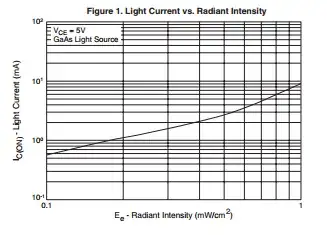When light strikes a semiconductor photodetector, each photon absorbed in the active region generates a free carrier pair (an electron and a hole). These carriers are swept out of the active region and form the photocurrent of the receiver. Some types of devices, like phototransistors and avalanche photodiodes, have an additional gain mechanism so that the initially generated photocurrent is multiplied by a gain factor.
The fraction of the incident photons that stimulate useful photocurrent is called the quantum efficiency, usually denoted as \$\eta\$.
The overall ratio of output current to incident optical power is the responsivity, R.
The responsivity can be expressed as
\$R=M\eta{}\dfrac{e}{h\nu}\$,
where M is the gain, e is the fundamental charge, \$h\nu\$ is the photon energy.
Now the relation between optical input power, \$P\$, and photodetector current is
\$I = RP\$.
For practical problems, you need to look at the datasheet of your phototransistor, which is likely to have a characteristic curve similar to this to indicate the responsivity:

